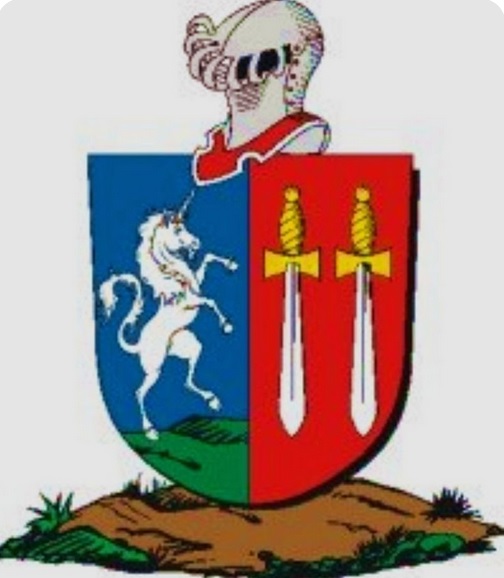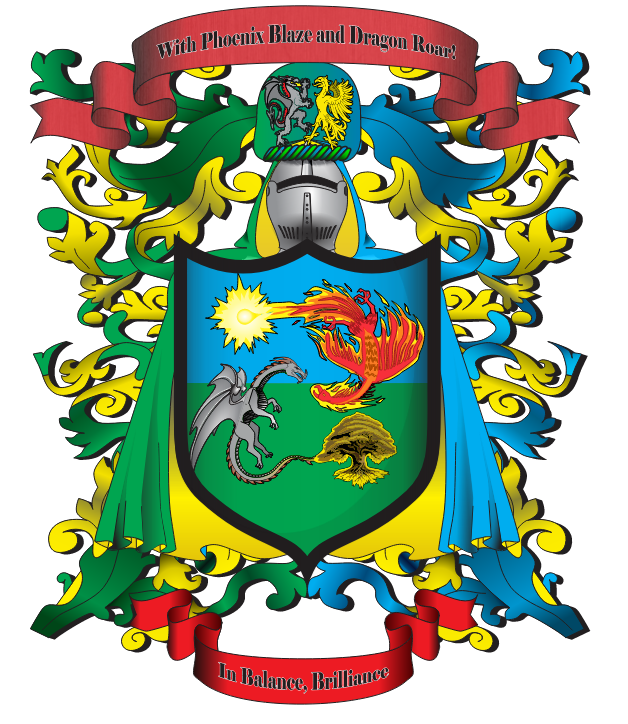Symbolism has been an integral part of my life for as long as I can remember. The allure of uncovering my family’s coat of arms, if one existed, has always intrigued me. My father took it upon himself to “send off” for a copy of our supposed coat of arms, but deep down, I have always harbored doubts about our lineage and whether we are truly entitled to such a rich heritage. The image of the coat of arms he received is displayed here. Still, without concrete proof, I find myself hesitant to fully embrace it as a genuine representation of our family’s legacy.
As time passed, my own ideals and beliefs began to take shape within me, and I felt compelled to capture these ideas on paper, translating them into a drawing that held profound meaning for me. Eventually, I immortalized this symbol on my right shoulder through a tattoo. It became a personal emblem, a visual manifestation of my inner convictions. Inspired by this concept, I am now embarking on the creation of a blazon—an official description of the symbol—to ensure its lasting presence for future generations. This endeavor allows me to document the essence and significance of the symbol, preserving its legacy.
The crux of my symbol revolves around the principles of balance, acceptance, and commitment. These ideals resonate deeply within me, guiding my actions and shaping my worldview. However, it is essential to acknowledge the uncertainty surrounding our family’s coat of arms. Without conclusive evidence, I approach this exploration with an open mind, embracing the possibility of uncovering new truths and forging my own interpretation of our ancestral heritage. Through this journey, I strive to honor the quest for authenticity and preserve the essence of my personal symbolism.
“Quarterly Party, first and second Azure, third and fourth Vert, in the first quarter a Sun radiant raised Or, from which to the dexter naissant a Phoenix volant en arrière Gules, descending embowed in an arc to the dexter and extending into the second and briefly into the fourth, the phoenix head fully contained within the fourth quarter and respecting the center point of the quarters, its wings, head, and tail enflamed Or; in the fourth quarter an Oak Tree eradicated Or feuillé, from which to the sinister naissant a Dragon volant en arrière Argent, ascending embowed in an arc to the sinister and extending into the third and briefly into the first, the Dragon’s head fully contained within the first quarter and respecting the center point of the quarters, wings elevated and addorsed Argent, its forelimbs and hindlimbs extended and taloned.”
“Above the shield, a Helm affronté, grilled Argent, mantled Azure and Vert, doubled Or, wreathed of the colours.“
“For a Crest, upon a Torse Or and Vert, a Phoenix Or and a Dragon Argent respectant, addorsed and rising, each from Flames proper.”
“A scroll above the crest bearing the War Cry, ‘With Phoenix Blaze and Dragon Roar!’, in letters Sable, and a scroll below the shield inscribed with the Motto, ‘In Balance, Brilliance’, also in letters Sable.”
“Quarterly Party, first and second Azure, third and fourth Vert“ establishes the foundational structure of the coat of arms. The quarterly division of the shield into four sections represents the division of the depicted domain or attributes. The first and second quarters in Azure, or blue, evoke a feeling of tranquility, stability, and trust. The third and fourth quarters in Vert, or green, symbolize life, renewal, and a deep connection to the natural world.
“in the first quarter, a Sun radiant raised Or, from which to the dexter naissant a Phoenix volant en arrière Gules, descending embowed in an arc to the dexter and extending into the second and briefly into the fourth, the phoenix head fully contained within the fourth quarter and respecting the center point of the quarters, its wings, head, and tail enflamed Or” introduces the prominent element of The sun is often associated with concepts such as life, vitality, enlightenment, and divine power. It represents light, warmth, and the energy source that sustains life. It can symbolize wisdom, clarity, guidance, leadership, transformation, renewal, and immortality. From the Sun, a Phoenix emerges in Gules, or red, the phoenix represents resilience, overcoming challenges, and the triumph of life over death, signifying the cyclical nature of life and the potential for personal growth and transformation, as well as the pursuit of truth and knowledge. The Phoenix extends into the second quarter and briefly into the fourth, with its head facing the center point of the quarters, emphasizing its transformative and guiding influence. The body of the Phoenix lies mostly in the second quarter, alone and without accompaniment, and implies the journeys in life are primarily individual travels. The positioning of the Phoenix indicates openness and acceptance. The flames surrounding the phoenix symbolize its fiery nature and association with regeneration. Fire is often associated with passion, creativity, purification, and purification. The flames represent the transformative and purifying aspects of the phoenix’s nature and signify the beginning of the cycle.
“In the fourth quarter, an Oak Tree eradicated Or, from which to the sinister naissant a Dragon volant en arrière Argent ascending embowed in an arc to the sinister and extending into the third and briefly into the first, the Dragon’s head fully contained within the first quarter and facing the center point of the quarters, its wings elevated and addorsed Argent, its forelimbs and hindlimbs extended and taloned” presents an Oak Tree in the fourth quarter. The oak tree is often associated with strength, endurance, and wisdom. Representing stability, resilience, and grounding. The oak symbolizes longevity and the life cycle, as it can live for many years and produce acorns that grow into new trees. It can also symbolize protection and shelter, as its strong branches provide shade and support. Cladding in Or indicates how precious this symbol is in the cycle of life. From the Oak Tree, a powerful mythical dragon emerges in Argent, or silver, symbolizing protection, wisdom, and guardianship. The Dragon extends into the third quarter and briefly into the first, with its head facing the center point of the quarters, highlighting its role as a powerful guardian figure and representing strength, courage, and guardianship. It can symbolize both destructive and protective forces. In this blazon, the dragon is depicted as volant en arrière (flying backward) with its wings elevated and addorsed (folded back). This may suggest a sense of watchfulness and readiness to defend or protect. The extended forelimbs and hindlimbs with talons indicate the dragon’s ability to grasp and hold onto what it values. The body of the Dragon lies mainly in the third quarter, alone and without accompaniment, and again as the Phoenix implies, the journeys in life are primarily individual travels. The positioning of the Dragon implies openness and acceptance.
“Above the shield, a Helm affronté, grilled Argent, mantled Azure and Vert, doubled Or, wreathed of the colours” introduces the Helm positioned above the shield. The Helm is depicted facing forward (affronté) and features a silver (Argent) grill. The mantling, represented in Azure and Vert, symbolizes drapery and is doubled in Or, emphasizing prestige and nobility. The wreath, made of the colors Azure and Vert, holds symbolic significance, connecting the Helm to the overall symbolism of the coat of arms.
“For a Crest, upon a Torse Or and Vert, a Phoenix Or and a Dragon Argent respectant, addorsed and rising, each from Flames proper” describes the Crest, positioned upon a Torse. The Torse consists of twisted bands in Or and Vert. The Crest features a Phoenix in Or and a Dragon in Argent, depicted facing each other (respectant) and back-to-back (addorsed), both rising. The creatures emerge from proper-colored Flames, symbolizing their transformative nature and power.
“above the crest, a scroll inscribed with the War Cry. ‘With Sun’s Blaze and Dragon’s Roar!’, in letters Sable” refers to a scroll positioned above the Crest. The scroll carries the War Cry, written in Sable (black) letters. The War Cry, ‘With Sun’s Blaze and Dragon’s Roar!’, represents the rallying cry and expression of strength associated with the depicted domain.
“below the shield, a scroll inscribed with the Motto, ‘In Balance, Brilliance’, also in letters Sable” describes a scroll positioned below the shield. This scroll carries the Motto, written in Sable letters, which reads ‘In Balance, Brilliance’. The Motto conveys the principles of harmony, equilibrium, and brilliance that guide the depicted realm.
Each element of the coat of arms holds symbolic significance, representing different qualities, values, and aspirations. The color choices, creatures, and textual elements come together to convey a narrative of strength, transformation, wisdom, and balance. They reflect the essence and ideals of the depicted domain, inspiring a sense of power, resilience, and brilliance.
Registered Blazon
On 18 July, 2023 I was granted a recorded blazon with the Committee on Heraldry of the New England Historic Genealogical Society which was established 3 February, 1864. They are the oldest registrar in the United States.
The submission to the committee was considered too complex and the committee reworked the blazon to simplify it while still keeping with the overall theme I intended. The arms are blazoned in Committee records as follows:
Arms: Per fess azure and vert, issuing from a sun in dexter chief gold a phoenix descending in an arc toward the sinister gules enflamed gold, and issuant from an oak tree uprooted in sinister base a dragon ascending in an arc toward the dexter gold, the heads respectant in fess point.
Crest: A phoenix gold and a dragon silver wings endorsed respectant and rising from flames proper.
There is a mistake in the coloring that I have requested be changed or explained, as the dragon in the original submission should be Argent (silver) and not Or (gold).
The original submission was as the description at the beginning of this post and I will provide it again here. Only the arms and crest were listed in the application, and I will bold them here appropriately.
“Quarterly Party, first and second Azure, third and fourth Vert, in the first quarter a Sun radiant raised Or, from which to the dexter naissant a Phoenix volant en arrière Gules, descending embowed in an arc to the dexter and extending into the second and briefly into the fourth, the phoenix head fully contained within the fourth quarter and respecting the center point of the quarters, its wings, head, and tail enflamed Or; in the fourth quarter an Oak Tree eradicated Or feuillé, from which to the sinister naissant a Dragon volant en arrière Argent, ascending embowed in an arc to the sinister and extending into the third and briefly into the first, the Dragon’s head fully contained within the first quarter and respecting the center point of the quarters, wings elevated and addorsed Argent, its forelimbs and hindlimbs extended and taloned.”
“Above the shield, a Helm affronté, grilled Argent, mantled Azure and Vert, doubled Or, wreathed of the colours.”
“For a Crest, upon a Torse Or and Vert, a Phoenix Or and a Dragon Argent respectant, addorsed and rising, each from Flames proper.”
“A scroll above the crest bearing the War Cry, ‘With Phoenix Blaze and Dragon Roar!’, in letters Sable, and a scroll below the shield inscribed with the Motto, ‘In Balance, Brilliance’, also in letters Sable.”

























